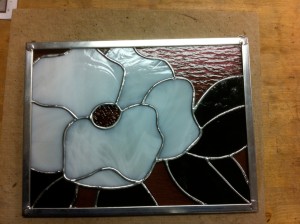
Faceted glass consists of approximately one-inch thick dalles of glass cut by hand and broken over an anvil. These pieces of glass are placed in a pattern on a table and a form is set around the perimeter of the panel. Sandy material called granules, are sprinkled between the pieces of glass. The next step is to pour a two-part epoxy resin between the pieces of glass. We then sprinkle another layer of granules over the epoxy resin. Once the epoxy sets, it results in a very strong load-bearing panel. Studios mainly use faceted glass for less complex designs. Faceted glass windows have a higher material costs but require significantly less labor, often making it a more cost effective solution. Faceted glass does not require a protective covering when installed and requires very little maintenance.
Leaded Stained Glass
Windows with little or no painted work are another type of stained glass art that studios commonly use. Leaded glass with little painted work is less labor intensive than fully hand painted cathedral windows. A Studio can design this medium to match most budgets and tastes. (See Step by step – leaded and painted construction below.) Read more »
 October 29th, 2020
October 29th, 2020 








![magnolia-window[1]](http://web.archive.org/web/20190505172416im_/http://artofstainglass.com/wp-content/uploads/2014/02/magnolia-window1-200x300.jpg)



